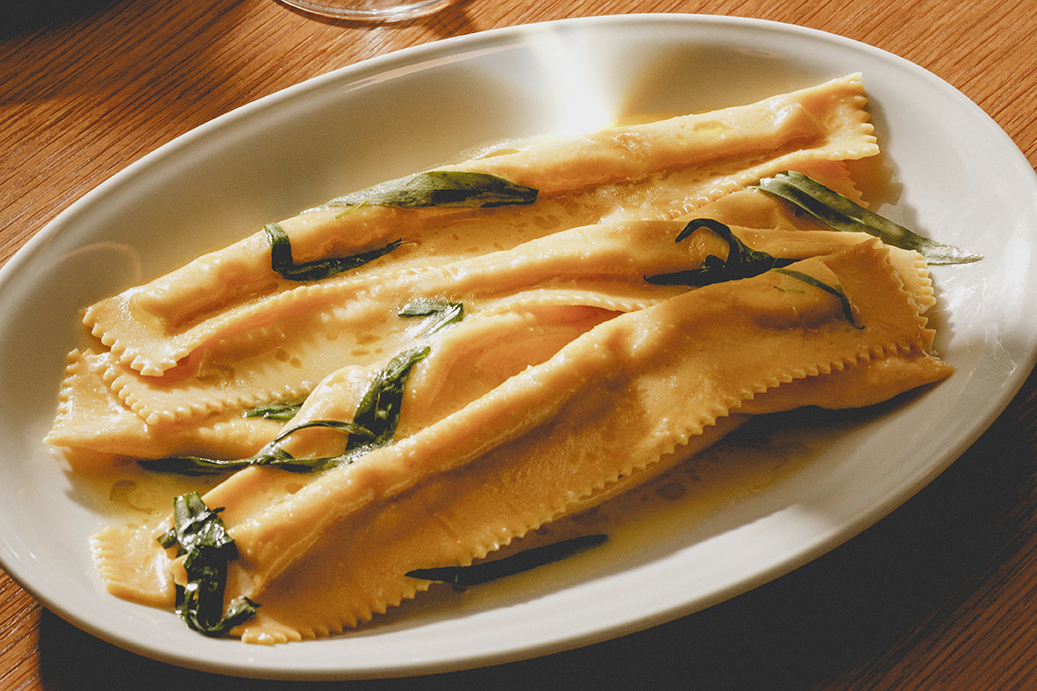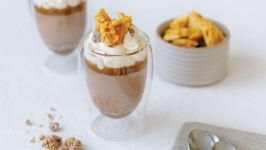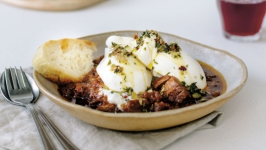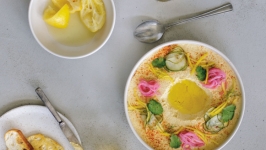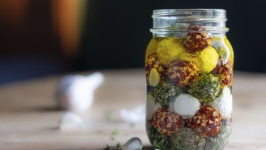Pasta Perfect
Flour plus water. Could anything be more basic? At the same time, could anything be more sublime? When I look back at my favourite meals over the last few years, they all seem to feature pasta. The five-course pasta tasting menu at Oca Pastificio (now Magari by Oca). The hand-rolled trofie, electric green and fragrant with pesto at Funke in Los Angeles. The ravioli at CinCin, drizzled in sage butter and showered in truffles and hazelnuts. The umami rich rigatoni cacio e pepe at Osteria Elio Volpe, savoury with the salty tang of aged cheddar.
Each was a triumph of simplicity, with the noodles acting as a toothsome vehicle for exceptional ingredients, just as they should.
But that rigatoni at Elio? It cost $34 for a full order. The Funke trofie was $35 for a smallish bowl — and that’s in U.S. dollars. At CinCin, the squash ravioli — without truffles— is $34. Bargain dining à la Lady and the Tramp this is not.
In fact, outside of joints like the Old Spaghetti Factory, pasta is becoming something of a luxury food — and that’s before it’s topped with caviar, truffles, Wagyu beef and the like. The question is, is it worth it?
Absolutely, says Phil Scarfone, the culinary director for Banda Volpi, the group behind Osteria Savio Volpe, Caffé La Tana, Pepino’s Spaghetti House and the newest restaurant in the group, Osteria Elio Volpe. There’s a lot of nuance with pasta, he points out. “The gap between OK pasta and beautiful pasta is large, and customers can tell.”
Despite the dent in my wallet, I can’t help but agree. Here’s why.
A pasta primer
First, a little background. Despite what you’ve likely been told, Marco Polo did not bring noodles back to Italy from China. Evidence shows that the Etruscans were already making pasta there in 400 BCE, more than 1,600 years before the Venetian explorer set out on the Silk Road.
Today, Italy has more than 300 pasta shapes known by some 1,000 different names, each matched with its own preferred sauce — tagliatelle with bolognese, hand-rolled trofie with pesto, bucatini all’amatriciana, stuffed pasta with buttery goodness.
And although all pasta generally starts as a paste of flour, water and maybe eggs, not all pasta is the same. Far from it.
At its most basic, pasta is either fresh or dried, and fresh is not necessarily better, as anyone who’s ever had a bowl of thick, gummy fettucine alfredo can attest. In many cases, dried pasta can be a much better choice. But it needs to be the right dried pasta, and usually that means artisanal rather than commercial pasta.
Most commercial dried pasta is made from two ingredients, semolina flour and water, which are mixed, rolled, flattened, pasteurized, cut with Teflon-coated dyes and dried quickly in ovens at relatively high heat. This is convenient and cost effective, for sure, but creates slippery noodles that can have an off-putting flavour and mushy texture when cooked.
Artisanal dried pasta, on the other hand, is also made from semolina and water and sometimes eggs, but it is cut using bronze dyes (look for “trafilata al bronzo” on the label), then dried slowly at low temperatures. This creates a coarser, more porous noodle, the better for gripping onto those delicious sauces, a delicate flavour and a springy texture when cooked.
Of course, the added time and work required to make artisanal pasta increases the price, as do higher-quality ingredients, which is why a packet of, say, Rustichella d’Abruzzo spaghetti will cost $8 or more compared to $2.99 for a commercial supermarket brand.
In either case, dried pasta is generally better for hearty, chunky sauces and quick, mid-week meals.
Somewhere between dried and fresh pasta is fresh-cut extruded pasta, a mix of semolina and water that is pushed through an extruder to create shapes that would be hard to make by hand, such as radiatore, rotini or the rigatoni that is so trendy right now at Elio Volpe and Funke.
Those machines are handy, but expensive. “You look at the food costs with a bunch of noodles and it costs me $5 to $7, but the pasta extruder machine is several thousand dollars,” Scarfone says. It’s worth it, though, he adds. The oversized rigatoni it creates “is a superior sauce vehicle for sure.”
And then there is fresh pasta.
To make it, eggs are mixed into flour, preferably finely ground 00 Italian flour, to create a dough that is kneaded, allowed to rest, then rolled thin using either a pasta maker or a giant rolling pin called a mattarello, after which it is cut and shaped.
Fresh pasta is essential for stuffed agnolotti, tortellini and ravioli; it’s also ideal for delicate sauces. Think tagliatelle with cream and truffles. It’s delightful, but it’s not always easy getting it right, and it takes time, labour and experience.
A lifetime of training
Indeed, mastering pasta can take a lifetime, and may involve serious study in Italy.
The beardy L.A.-based chef Evan Funke, who has probably done more than anyone in North America to take handmade pasta from the realm of Italian nonnas into hipster chef circles, studied with Alessandra Spisni at La Vecchia Scuola Bolognese. His book American Sfoglino is the reason the mattarello is the coolest kitchen gadget among a certain type of cook.
Adam Pegg, chef-owner of La Quercia/L’Ufficio in Kitsilano, studied at the Italian Slow Food School where he became the first Canadian to earn the Master of Italian Gastronomy. He still handcrafts pastas using century-old techniques and has become a mentor to many Vancouver chefs, including the late Gregory Dilabio, who opened the all-pasta, all-the time Oca in 2019. (He tragically passed away in July 2023; the walk-in restaurant has since re-opened as Magari by Oca and still serves its famed pasta tasting menu and has earned a Michelin Bib Gourmand.)
Scarfone, meanwhile, grew up in an Italian family, where every Sunday his nonna served penne rigate with the sauce she made from tomatoes she grew in her own garden. “My whole life has been pasta,” he says.
That’s true now more than ever.
“Pasta plays a cornerstone in each of our restaurants,” he says. “We honour both classic and new in our locations.”
Pepino’s, for instance, offers old-school North American Italian pasta — spaghetti and meatballs in a Sunday sugo, linguine alle vongole, cannelloni stuffed with ricotta and bathed in pomodoro — in a room where Dean Martin would feel right at home.
Caffé La Tana next door is a bit more classic Italian and features a bar where guests can watch the pasta chef make whatever he’s in the mood for, perhaps a tortellini de zucca, stuffed with Italian squash. They can also visit a market selling fine Italian foods, including fresh-made noodles to cook at home.
Savio Volpe tends to the hearty and seasonal; think saffron linguini with side-stripe shrimp or tagliatelle with pork ragu and pecorino romano. “The menus just write themselves,” Scarfone says, adding, “At [Osterio] Elio, we’re a bit more playful.”
That could mean a sesame spaghetti “that almost doesn’t make sense, but is delicious” or the rigatoni cacio e pepe, where the pecorino is replaced by aged cheddar and the whole comes with charred jalapeño jam. “I think cheddar and jalapeño is a classic combination. It’s very, very good,” he says. (It is.)
Each of the properties has a pasta extruder that can “make an infinite number of shapes” in house. And, Scarfone says, “We have four people whose job is just to make noodles all day. Their whole life is pasta and dough and flour. It’s a real skill, running the pasta station.”
It’s a coveted position, and not for everyone, he says, adding: “Pasta is a living, breathing thing that changes according to how big your eggs are and the relative humidity in the air. You have to be pretty nimble to be a good pasta cook.”
A plethora of pasta joints
Making pasta takes time, money and effort. But at the end of the day, it’s still just flour, water and maybe eggs, a bit of cheese and whatever you top it with. And while eggs are eyewateringly expensive these days, especially if you go through 150 of them a day like Banda Volpi does, pasta is still a lot less costly to make than, say, seafood or steak.
That’s why, during the worst days of the pandemic, when restaurants were struggling with closures and restrictions, many of them began pumping out pizza and pasta rather than whatever they had previously done. It was cheap to make, everyone liked it and it travelled well in an insulated takeout bag.
And perhaps that’s why, even though many restaurants are still struggling and others have closed since the pandemic hit in early 2020, so many Italian joints have popped up all over the place. They are, if not thriving, surviving better than so many others.
Among them: Kitchen Table Group’s Ask for Luigi now has a mercato spinoff on East 12th, where it sells a line of fresh take-home pastas and sauces it developed during the pandemic. In 2021, the owners opened the Venetian-style Bacaro (at the Fairmont Pacific Rim) and Friulian Carlino (at the Shangri-La Hotel).
That same year, the ultraluxe Acquafarina opened on Georgia Street after many delays, while Fiorino Italian Street Food opened in Chinatown, Caffe La Tana evolved from café to pasta-and-wine bar, and Autostrada opened its third location, at Vancouver House, a year after opening Capo & The Spritz at the Opus Hotel.
Even in the grim pandemic year of 2020, the stylish Tutto opened in Yaletown. Two years later, chef Andrey Durbach returned to Vancouver and his first love, Italian cuisine, to launch Impostori Trattoria on South Granville.
And even as Gooseneck Hospitality permanently shuttered its beloved, ground-breaking, nose-to-tail restaurant Wildebeest as pandemic restrictions dragged on, it has just opened its third Bufala restaurant serving pizza and pasta, this one an 80-seat room designed by Ste. Marie in the River District.
Also this year, Elio Volpe opened in March with Locanda dell’Orso, an “Italian concept” on Pender Street, to come.
Why all this and why now?
Well, on the one hand, pasta is a restaurateur’s best friend. It doesn’t spoil like meat or dairy, and it costs way less. Plus chefs will quietly admit they sometimes charge a little more for pasta so they can charge a little less for pricier items like the beef tenderloin or halibut.
But mostly it’s because it makes us happy. Pasta is comforting and delicious and it’s fun to eat, even if it does cost $35 a bowl.
As Scarfone says, “Nothing beats a warm bowl of noodles when you are sharing them with your friends. It contributes to more of a convivial atmosphere when people are sharing pasta.”
And, if you ask me, that’s priceless.
Osteria Elio Volpe
540 W. 17th Ave., Vancouver
eliovolpe.com | 236.471.9564 | @elio.volpe


